
The Cathedral of Our Merciful Saviour in Faribault is the oldest cathedral in Minnesota. Built 1862–1869, it was the first church in the Episcopal Church in the United States of America designed as a cathedral. The architect was James Renwick Jr., who also designed St. Patrick's Cathedral in New York, the Smithsonian Institution Building in Washington, D.C., and a very similar church, the Christ Church by the Sea in Colón, Panama. On August 10, 1979, the cathedral and its guild house were added to the National Register of Historic Places. On February 19, 1982, there was a boundary increase to add the bishop's residence to the National Register.

Hastings Methodist Episcopal Church is a church building located at 719 Vermillion Street in downtown Hastings, Minnesota, United States, listed on the National Register of Historic Places. It is significant for its Gothic Revival, Greek Revival, and Italianate architecture. The building exterior is clapboard with a characteristic tower including abat-sons and emphatic eaves supported by corbels. It is the oldest church building in Hastings, originally built in 1862 on 5th Street, it was moved to its present location in 1871; at that time the tower was added. The building is currently used by the Life Tabernacle Pentecostal Church.

St. Mark's Episcopal Church, now the Episcopal Parish of St. Mark and St. John, is a historic Episcopal church at 21 Race Street in Jim Thorpe, Carbon County, Pennsylvania. Completed in 1869, it is a prominent example of Gothic Revival architecture designed by that style's leading proponent, Richard Upjohn. It is one of Upjohn's last designs, and was largely funded by Asa Packer, a local millionaire whose fortunes were made in the coal fields. It was added to the National Register of Historic Places in 1977, and declared a National Historic Landmark in 1987.

St. Stephen's Episcopal Church is an historic Episcopal church building located northeast of Ridgeway, South Carolina, on County Road 106. Built of wood in 1854 in the Carpenter Gothic style, it was designed by the Rev. John Dewitt McCollough, who later became its rector. The exterior was painted a maroon color. In 1920, its exterior wood was covered by brick veneer, so that it appears today as a brick Gothic Revival style building on the outside while the interior retains its Carpenter Gothic features. A wing was added in the 1940s to create space for a parish hall and Sunday school.
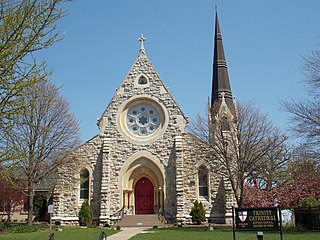
Trinity Episcopal Cathedral, formerly known as Grace Cathedral, is the historic cathedral in the Diocese of Iowa. The cathedral is located on the bluff overlooking Downtown Davenport, Iowa, United States. Completed in 1873, Trinity is one of the oldest cathedrals in the Episcopal Church in the United States. It was individually listed on the National Register of Historic Places in 1974. In 1983 the cathedral was included as a contributing property in the College Square Historic District, which is also listed on the National Register.

The Mechanicsburg Baptist Church is a historic church in the village of Mechanicsburg, Ohio, United States. Constructed for a Methodist congregation in the late nineteenth century, the building was taken over by Baptists after the original occupants vacated it, and it has been named a historic site.

Trinity Episcopal Church is a parish church in the Episcopal Diocese of Iowa. The church is located in Iowa City, Iowa, United States. It was individually listed on the National Register of Historic Places in 1974. In 2021, the building was included as a contributing property in the Iowa City Downtown Historic District.

St. Mary's Chapel is a historic Episcopal chapel located at 900 Hillsborough Street in Raleigh, North Carolina, United States. The chapel is on the grounds of St. Mary's School, a college-preparatory boarding and day school founded in the 1840s. The 19th century building was designed by architect Richard Upjohn in the Gothic Revival style and later expanded. It was added to the National Register of Historic Places (NRHP) in 1970.

St. James Episcopal Church is a parish of the Diocese of Iowa located in Oskaloosa, Iowa, United States. It was listed on the National Register of Historic Places in 1991.
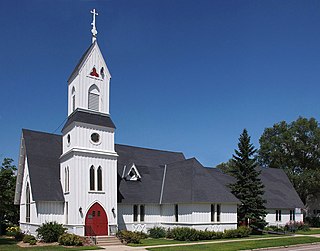
Trinity Episcopal Church is an Episcopal church in Litchfield, Minnesota, United States, built in 1871 in Carpenter Gothic style. It has been attributed to the noted New York architect Richard Upjohn. It was listed on the National Register of Historic Places in 1975 for having local significance in the theme of architecture. It was nominated as a superlative example of Carpenter Gothic design from the mid-19th century.
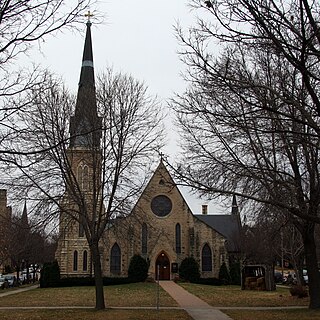
The parish of Christ Episcopal Church in Red Wing, Minnesota, United States, was founded in 1858. A wooden building was erected that served the early parish well, but by 1868 it was felt that the growth of the parish made the building of a larger church a necessity.
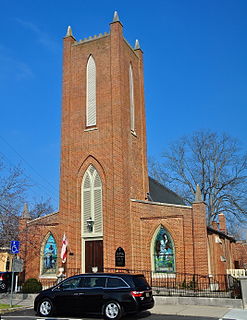
St. Paul's Episcopal Church is a historic church in Franklin, Tennessee, that was listed on the National Register of Historic Places in 1972. In 1988, a National Register study of Williamson County historical resources described it as "one of the finest remaining" Gothic Revival style churches in middle Tennessee. The building was completed in 1834.
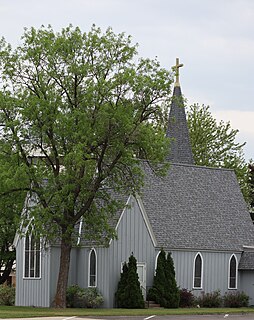
Christ Episcopal Church is a historic church building in Benson, Minnesota, United States. It is Benson's oldest church, built in 1879 as part of the Episcopal Church's ambitious expansion into western Minnesota under Bishop Henry Benjamin Whipple.
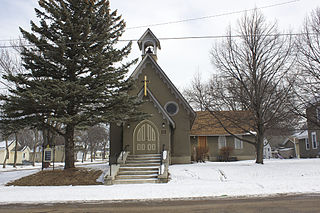
Gethsemane Episcopal Church is a historic Episcopal church building in Appleton, Minnesota, United States. It was built in 1879 during the episcopate of pioneer Bishop Henry Benjamin Whipple. It was originally a wooden-frame structure with the board and batten walls and lancet windows typical of Carpenter Gothic style. Around 1920 the interior and exterior walls were plastered over, which greatly changed its appearance and obscured its Carpenter Gothic origin. Over the years additions were made to the building and a basement was added.

Kemper Hall is the complex of an Episcopal college in Kenosha, Wisconsin, United States which began with an Italianate mansion and was expanded with various wings and buildings in Gothic Revival style. It was added to the National Register of Historic Places in 1976.

St. Mark's Pro-Cathedral is an Episcopal Church building located in Hastings, Nebraska, United States. It has been listed on the National Register of Historic Places since 1987.
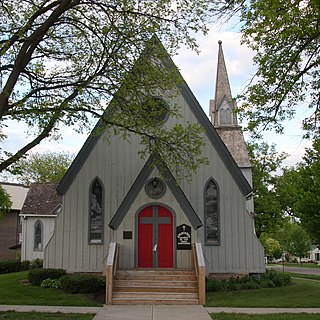
Church of the Good Shepherd Episcopal, a notable example of Rural Gothic architecture located at Moore and 8th Streets in Blue Earth, Minnesota, is the oldest surviving church building in the community. As the congregation diminished in the 1970s regular worship services were eventually suspended; in 1981 its three remaining members donated the building to the Faribault County Historical Society. Since then the church has hosted seasonal ecumenical services, Christmas concerts, weddings, and funerals. It was added to the National Register in 1980.

St. Cornelia's Episcopal Church is a historic church on the Lower Sioux Indian Reservation near Morton, Minnesota, United States. It was built 1889–91 for a Dakota congregation returning after years of exile from Minnesota following the Dakota War of 1862. It is also an example of the Episcopal missionary work among Native Americans and fine Gothic Revival church construction under Bishop Henry Benjamin Whipple (1822–1901). St. Cornelia's was added to the National Register of Historic Places in 1979. It was listed for having state-level significance in architecture, exploration/settlement, and religion.

The Church of St. Michael is a historic Roman Catholic church building in St. Michael, Minnesota, United States, constructed in 1890. It was listed on the National Register of Historic Places in 1979 for having local significance in the themes of architecture, exploration/settlement, and religion. It was nominated for its status as the dominant architectural feature and the religious and social center of a German Catholic community.

The Park-to-Park Residential Historic District in Fort Madison, Iowa, United States, was listed on the National Register of Historic Places in 2014. The historic district is located to the north of the Downtown Commercial Historic District, generally between Central Park on the west and Old Settler's Park on the east. Both parks are contributing sites. For the most part the district is made up of single family homes built in the late 19th and early 20th centuries. Some of these homes were built as rental properties, while others became so in later years. The Albright House and the Chief Justice Joseph M. Beck House are contributing properties, and they are also individually listed on the National Register. There are also duplexes and a few small scale apartment buildings in the district.
























